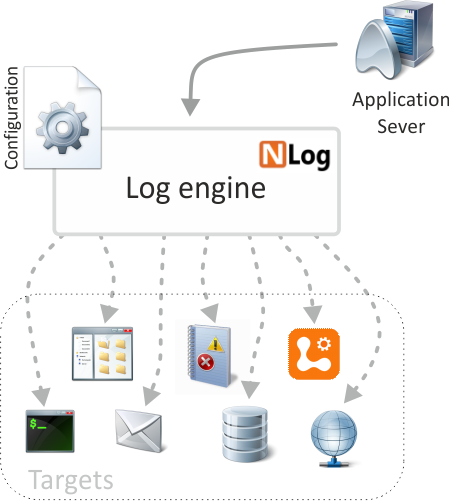

The Application Server logs information that might me valuable to administrators or support personnel for tuning performance, tracking down configuration errors and finding reasons for errors. The data logged is logged in form of log messages that contain textual information in English language together some meta-data as described in table 1.
For a persistent record of these log messages the Application Server makes use of a logging engine based on the NLog logging platform. This logging engine allows you to configure where and how log messages are persisted. The Application Server comes with a default configuration for this logging engine that advices the logging engine to persist log data to files in the log directory and to the Windows Event Log (based on certain conditions). If you want to change the logging configuration you can do so by creating an NLog configuration file. You can define your own log targets (where log messages will be persisted) and rules that route log messages to targets based on conditions. The logging engine supports over 20 types of log targets, among them the file system, the Windows event log, email, logentries.com, etc.

Figure 1: The Application Server's log engine
All log data the Application Server issues before the logging engine is started (during the Application Servers start-up process) is logged directly to the Windows Event Log.
Log entry element |
Description |
Log message source |
Source the log message originates from. Possible log message sources are listed in table 2. |
Time stamp of logging |
Date and time when the log entry was generated |
Message |
Textual information |
Log level |
One of the following values •Trace - very detailed logs, which may include high-volume information such as protocol payloads. This log level is typically only enabled during development •Debug - debugging information, less detailed than trace, typically not enabled in production environment. •Info - information messages, which are normally enabled in production environment •Warn - warning messages, typically for non-critical issues, which can be recovered or which are temporary failures •Error - error messages •Fatal - very serious errors |
System exception |
Exceptions thrown by the system (if any) |
Table 1: Data stored in a log message
Log source |
Description |
Common |
Log messages that originate from components used by all other pars of the application Server (see below) |
Server |
Log messages originating from the Application Servers host process. Especially all Start-up and Shutdown messages. |
BusinessLayer |
Log messages that originate from the Application Server's business layer. This includes most log messages for the internal logic of the Application Server. |
Licensing |
Log messages from the licensing engine |
ServiceLayer |
Log messages from the service layer, including all messages concerning the communication of the Application Server. |
DataLayer |
Log messages of the data layer, i.e. all messages that deal with data transfer to and from the Application Server Database |
Connector |
Log messages that originate from connector features. |
Table 2: Log message sources
